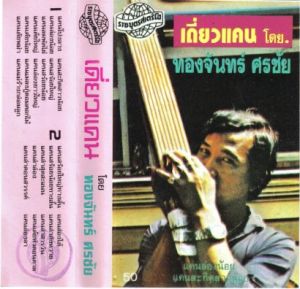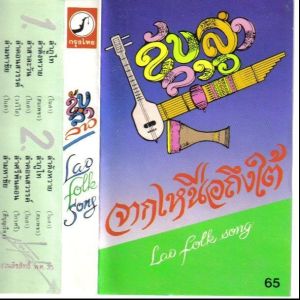Balinese Gamelan Gong Gede Vol. 2 – STSI, Denpasar, Bali
November 15, 2012
Side A:
Side B:
“Best of Northeast Native Melody” – Northeast Thailand
November 15, 2012
PART 1
PART 2
PART 3
PART 4
Field Recordings – Bali/Java 1998
February 7, 2011
This is a recording made in Tabanan, Bali in summer of 1998. That particular day was a holiday (one of the Balinese Hindu festivals, but I don’t recall the specific occasion). There were celebrations all over the place in Bali that week, and this was a street festival with an unusual hybrid gamelan of bamboo and metal instruments; the next day Balinese friends took us to watch a funeral procession; the coffin was elaborately decorated and carried by about a dozen men, who struggled to keep it on the path as it lunged back and forth. It was explained to us that this was caused by the spirit of the deceased seeking to remain in the world rather than be laid to rest at the cemetary…
A Balinese friend’s grandfather had toured the US in the 60s with his Gamelan (Tabanan is known as one of the main centers for Gamelan in Bali). We visited him and he graciously sang a folk song recounting stories from the Mahabharata, and played a song for us on suling (end-blown bamboo flute). This was actually the same suling which he brought to the US in the 60s; he gave it to me as a gift after our many visits with him.
Buskers on Javanese public buses 1
Buskers on Javanese public buses 2
Buskers on Javanese public buses 3
Taking the buses and trains around Java you’ll often encounter merchants hopping on and walking through, selling snacks or children’s toys, and guys who walk through the aisles with a guitar singing original material or traditional folk songs. My visit was just after the riots and political turmoil in 1998, and we heard a lot of original songs about the Suharto regime, the corruption of the military and so on. On certain point in these recordings you can also hear a little kid battling it out with the musicians crossroads-duel style using a squeaky toy…
Field Recordings – Nepal 1998
February 6, 2011
These recordings were all made in October of 1998 during a visit to Nepal, using a cassette recorder with a built-in condenser mic, so the recordings are definitely not audiophile quality by any means, but hopefully will be of some interest. Recordings made in Indonesia and Thailand during the same period (and more in keeping with the regional specification of the title of this blog) will be forthcoming in the next few days…
Boudanath prayer wheels at sunset
Boudanath, located on the outskirts of Kathmandu, is (if I remember correctly) the most important Tibetan stupa outside of Tibet itself. Every day at sunset people come out to walk around the stupa and spin the prayer wheels, which line the outside of the stupa and issue prayers and/or blessing when spun.
Tibetan nun chanting at Boudanath
An elderly Tibetan nun was chanting over a bunch of votive candles in the courtyard the same evening.
Tibetan horns and dogs barking
recorded from the window of the guesthouse where I was staying outside of Boudanath. There are loads of monasteries in the area and you would often hear chanting, ritual horns, and other such sounds coming from indeterminate and unseen origins during the sun-bleached, high altitude Kathmandu midday.
Nepali street musician and daughter part 1
Nepali street musician and daughter part 2
Nepali street musician and daughter part 3
Was walking around a neighborhood of Kathmandu near one of the markets and happened across a folk musician and his little daughter playing for tips. The guy was playing a 4 stringed vertical sarangi carved out of a single piece of wood, and the daughter was about 7 years old and was an adorable little kid. I’m really glad I was able to capture so much of their playing, and that I happened to have an extra blank tape with me! It reminds me of Norwegian hardanger fiddle playing in some ways, strangely…
Laos – Kaen Solo Pieces
February 12, 2010
This is a tape I bought in Luang Prabang, Laos, in October 1996. The pieces are all solo performances on the kaen, which is a bamboo free-reed mouth organ considered to be the national instrument of Laos and a symbol of Lao identity. The different regional styles of kaen playing are discerned by the rhythms used in the phrasing, and traditional folk melodies are used as a springboard for complex improvisations in each piece. Unfortunately, this instrument is rapidly being replaced by cheesy electronic keyboards in Lao music, a trend that will hopefully see a reversal soon.
“Lao Folk Song”
January 13, 2010
Bought at a shop in Van Vieng, Laos in 1996. Lao folk music, which can be heard in Northeast Thailand as well, is based around vocal singing and storytelling accompanied by the Kaen (a bamboo free-reed mouth organ, varieties of which are found throughout Southeast and East Asia). The production on this is pretty terrible, with tons of drum machines and keyboards cheesing everything up, but I still find it quite enjoyable. You can hear the Kaen in most of the songs on this cassette although it might be buried in the mix, and the keyboard and guitar (actually, it’s an electrified 2-string lute) lines mimic that of the Kaen. The vocals are the main draw here for me, the ornamentations and octave leaps are absolutely thrilling. Lao is a tonal language (as are most of the languages in Southeast Asia once you get north of Malaysia) and as I understand, the melodies are sung in accordance with the pronunciation rules for each word (for example, the falling tone that distinguishes one word from another similar word will be incorporated into the melody of a song to keep the meaning of the lyrics intact). In fact, there are instrumental forms of music in the region used for ritual purposes in which the instrument’s melody line will follow the articulations of speech to communicate a specific idea or meaning, even when there are no lyrics at all. So a certain melody, played a certain way, can communicate specific instructions to deceased relatives regarding the best way to find one’s path through the afterlife, for example. The way the songs are structured is really interesting to me as well, as the lyrics seem to dictate the length of each measure so the lines stop and start in unexpected places. I hear some parallels between this and the West African “desert blues” of Tinariwen and Etran Finatawa that has become popular internationally – everything’s pentatonic, lots of hypnotic repetition, almost a blues feeling to it (to my ears).
Hello.
January 8, 2010
I made a couple of trips through Indonesia, Singapore, Malaysia, Thailand, and Laos in the late 1990s and bought a bunch of cassettes of local music (this being one of the main things that drew me to traveling in the region). I thought it might be a good idea to post those tapes here for posterity before they disintegrate further, since I’ve never seen examples of some of these types of music released outside their countries of origin. I’ll do my best to include a scan of the cover, and a word or two about the music if I can.
I also brought a cassette recorder on my second trip in 1998, so I have a number of extremely unprofessional and low-fidelity field recordings that might be of some interest. I’ll be posting those as well, along with some basic explanation of the circumstances surrounding their creation.
These are all sourced from a bunch of tapes that have sitting in a shoebox in my closet for more than 10 years, and other than the field recordings are the result of multiple generations of dubbing and hence the sound quality is definitely not the cleanest, but I hope you find them interesting in any case.

